Extraction of Rhenium and Osmium from Lead Technogenic Raw Materials of Copper Production
Abstract
:1. Introduction
- -
- -
- -
- Oxidation of osmium and rhenium occurs during oxidation roasting of raw materials and their collective transition into substrates, which requires their separation at the next stages of processing, and also in substrates’ concentrate toxic elements such as arsenic and mercury contaminating osmium and rhenium containing intermediate products;
- -
- The conversion of lead sulfate into solution requires huge amounts of saturated sodium chloride solutions, the subsequent regeneration of which requires significant capital expenditures. Moreover, a product of processing is the collective concentrate of osmium and rhenium.
2. Materials and Methods
3. Results
3.1. Results of Reduction Smelting
3.2. Thermogravimetric Studies
4. Conclusions
Author Contributions
Funding
Institutional Review Board Statement
Informed Consent Statement
Data Availability Statement
Acknowledgments
Conflicts of Interest
References
- Zinesh, A.; Zagorognyaya, A.N.; Bukurov, T.N. Recovery of Radiogenic Osmium-187 from Sulfide Copper Ores in Kazakhstan. Platinum Metals Rev. 2001, 45, 132. [Google Scholar]
- Bodun, A.I.; Petrov, G.V.; Spynu, A.I.Y.; Andreev, I.Y.V.; Mardar, I.I. Rhenium extraction in hydrometallurgical processing of osmium-containing semi-products of sulfide copper ores [Izvlechenie reniıa pri gidrometallurgicheskoi pererabotke osmiisoderjaşih poluproduktov sulfidnyh mednyh rud]. Zap. Gorn. Inst. 2012, 202, 161–163. [Google Scholar]
- Berdikulova, F.A.; Sydykov, A.O.; Zharmenov, A.A.; Terlikbayeva, A.Z.; Seidakhmetova, N.M. Thermogravimetric Study of Oxidation Firing of Rhenium- and Osmium-Containing Lead Sludge. Metallurgist 2021, 64, 1096–1102. [Google Scholar] [CrossRef]
- Abisheva, Z.S.; Zagorodnıaıa, A.N.; Bobrova, V.V.; Sadykanova, S.; Aitkaliev, T.N.; Bekturganov, N.S. Sposob Pererabotki Vıazkih, Smolistyh Promproduktov, Soderjaşih Renii, Osmii i Organiku. Patent RK No 19853, 15 November 2010. [Google Scholar]
- Zharmenov, A.A.; Sydykov, A.O.; Idrissova, K.S.; Serikbayeva, A.K.; Berdikulova, F.A. Leady Slime Processing Comprises Leaching of Slime with Transfer of Rhenium into Solution Carried Out by Hydrogen Peroxide Solution with Transfer of Osmium into Gaseous Phase. Patent KZ No13819-B, 16 July 2007. [Google Scholar]
- Andreev, I.Y.V.; Greiver, T.N.; Petrov, G.V. Sposob Otgonki Reniıa i Osmiıa v Gazovuiy Fazu iz Svintsovistyh Reniisoderjaşih Pylei i Sernokislotnyh Şlamov Mednogo Proizvodstva. Patent RF 2051192, 27 December 1995. [Google Scholar]
- Abisheva, Z.S.; Zagorodnyaya, A.N.; Bekturganov, N.S. Review of technologies for rhenium recovery from mineral raw materials in Kazakhstan. Hydrometallurgy 2011, 109, 1–8. [Google Scholar] [CrossRef]
- Serikbayeva, A.K.; Suieybergenova, A.A.; Berdikulova, F.A. Review of technologies of processing of technogenic products of copper production. Metallurgijia 2015, 54, 715–717. [Google Scholar]
- Edenbaev, S.S.; Junusova, G.J.; Kalıanova, O.A. Izvlechenie osmiıa iz kekov avtoklavnogo vyşelachivaniıa svintsovoi pyli medeplavilnogo proizvodstva. Molod. Uchenyi 2011, 11, 15–17. [Google Scholar]
- Serikbayeva, A.K.; Berdikulova, F.A.; Mamyrbayeva, K.K.; Akilbekova, S.K. Processing of rare metals containing waste of copper production. Metallurgija 2018, 4, 345–348. [Google Scholar]
- Abişeva, Z.S.; Zagorodnıaıa, A.N.; Şaripova, A.S.; Bukurov, T.N.; Abadildinov, M.S. Kompleksnaıa pererabotka svintsovyh şlamov mednogo proizvodstva. Tsvetnye Met. 2002, 3, 33–36. [Google Scholar]
- Kiseeva, E.S.; Fonseca, R.O.; Smythe, D.J. Chalcophile Elements and Sulfides in the Upper Mantle. Elements 2017, 13, 111–116. [Google Scholar] [CrossRef] [Green Version]
- Harvey, J.; James, M.D. Highly Siderophile and Strongly Chalcophile Elements. In High-Temperature Geochemistry and Cosmochemistry; Springer: Berlin/Heidelberg, Germany, 2016; Volume 81, 771p. [Google Scholar]
- Habashi, F. Rhenium, Physical and Chemical Properties. Encycl. Met. 2013, 1–29. [Google Scholar] [CrossRef]
- Liu, J.; Huang, S.; Chen, K.; Li, J.; Wang, T.; Mei, M. Recovering metallic Pb directly from lead smelting dust by NaOH-carbon roasting process. J. Mater. Res. Technol. 2020, 9, 2744–2753. [Google Scholar] [CrossRef]
- Ermakov, L.V. Analytical Chemistry of Rhenium [Analiticheskaıa himiıa reniıa]. M. Nauka 1974, 318. (In Russian) [Google Scholar]
- Ginzburg, S.I.; Ezerskaıa, N.A.; Prokofeva, I.V.; Fedorenko, N.V.; Şlenskaıa, V.I.; Belskii, N.K. Analytical Chemistry of Platinum Metals [Analiticheskaıa himiıa platinovyh metallov]. M. Nauka 1972, 614. [Google Scholar]
- Vladimirov, L.P. Termodinamicheskie raschety ravnovesiıa metallurgicheskih reaktsii. Moskow Metall. 1970, 528. [Google Scholar]
- Sedyh, V.I.; Tupitsyn, A.A.; Bychinskii, V.A. Termodinamicheskii analiz okislitelno-vosstanovitelnyh protsessov s uchastiem sulfida svintsa. Tsvetnaıa Metall. 2001, 1, 18–21. [Google Scholar]
- Zheng, Y.-X.; Liu, W.; Qin, W.-Q.; Jiao, F.; Han, J.-W.; Yang, K.; Luo, H.-L. Reduction of lead sulfate to lead sulfide with carbon monoxide. J. Cent. South Univ. 2015, 22, 2929–2935. [Google Scholar] [CrossRef]
- Bimiş, F. Analytical Chemistry of Noble Metals. [Analiticheskaıa himiıa blagorodnyh metallov]. M. Mir 1969, 2, 180. [Google Scholar]
- Sobotka, B.M.; Mudring, A.V.; Moeller, A. Synthesis, Crystal Structures and Properties of Na2ReO3 and of a Second Modification of Na5ReO6. Z. Anorg. Allg. Chem. 2004, 630, 2377–2383. [Google Scholar] [CrossRef]
- Satbaev, B.; Yefremova, S.; Zharmenov, A.; Kablanbekov, A.; Yermishin, S.; Shalabaev, N.; Satbaev, A.; Khen, V. Rice Husk Research: From Environmental Pollutant to a Promising Source of Organo-Mineral Raw Materials. Materials 2021, 14, 4119. [Google Scholar] [CrossRef]
- Lin, G.; Huang, J.; Zhang, Y.; Hu, P. A Sustainable Technique to Prepare High-Purity Vanadium Pentoxide via Purification with Low Ammonium Consumption. Materials 2022, 15, 1945. [Google Scholar] [CrossRef]
- Georgiev, G.T. Kontsentrirovanie osmiıa metodom nepolnogo kupelirovaniıa. Anal. Him. 1978, 33, 745–748. [Google Scholar]

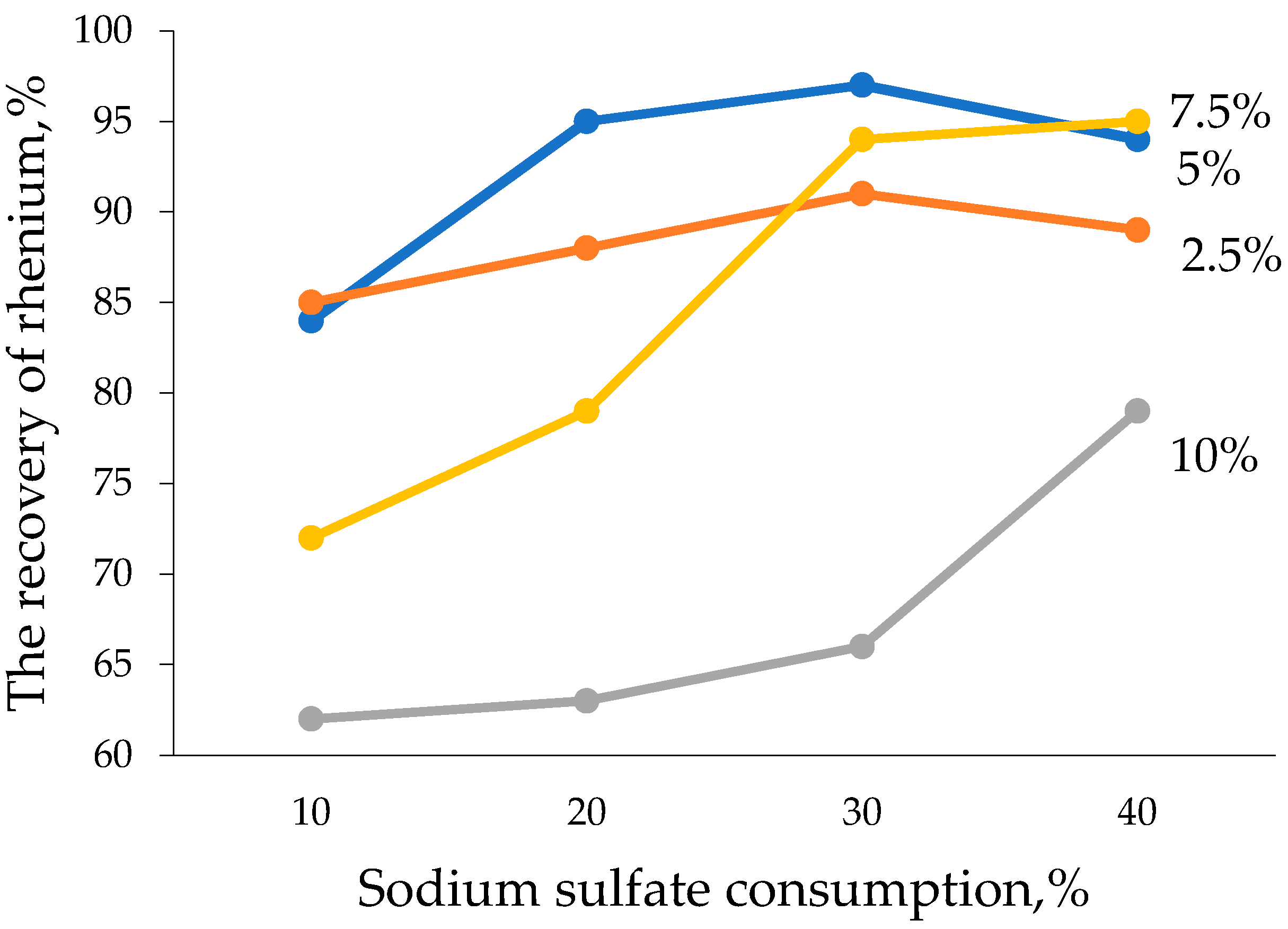
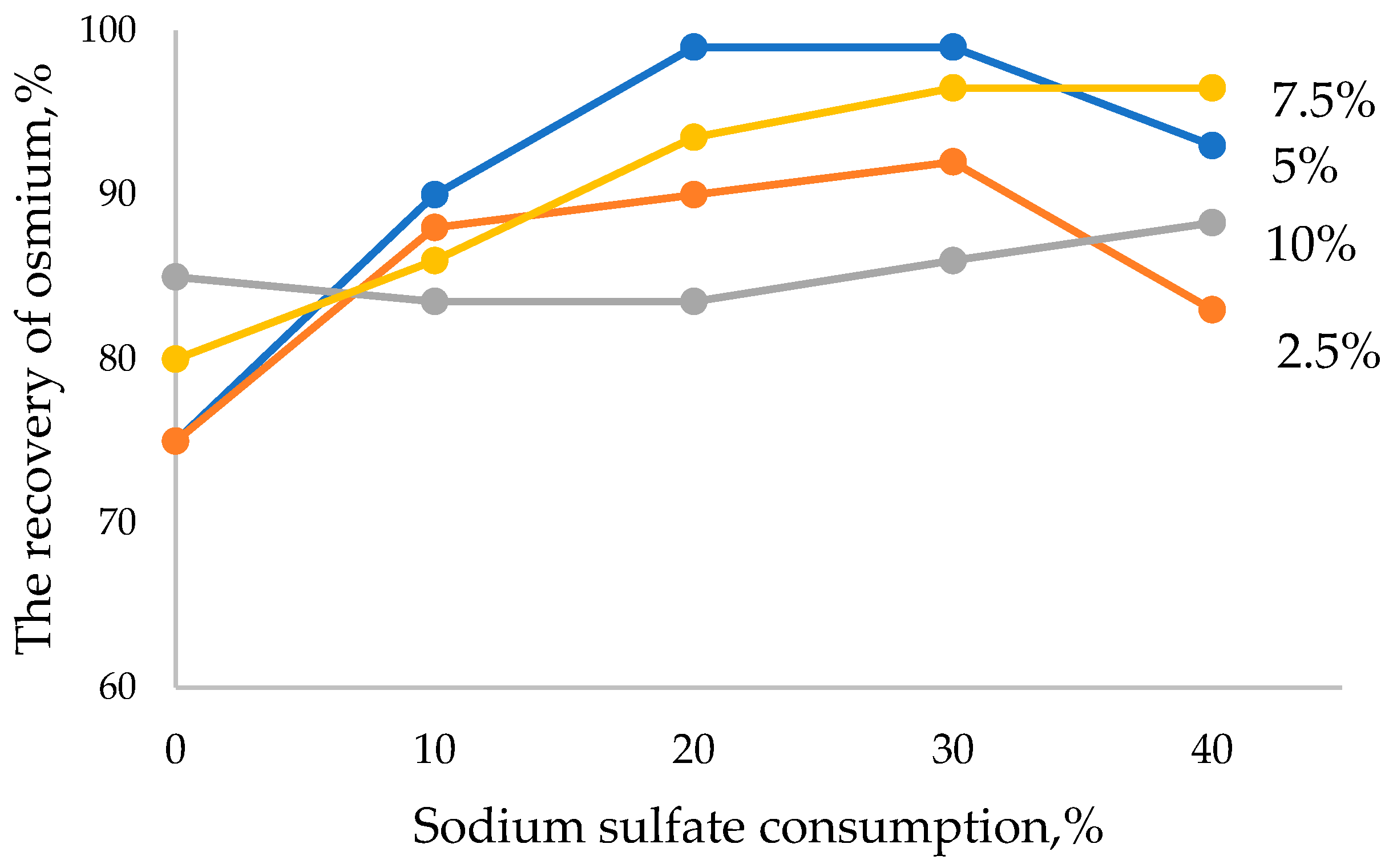
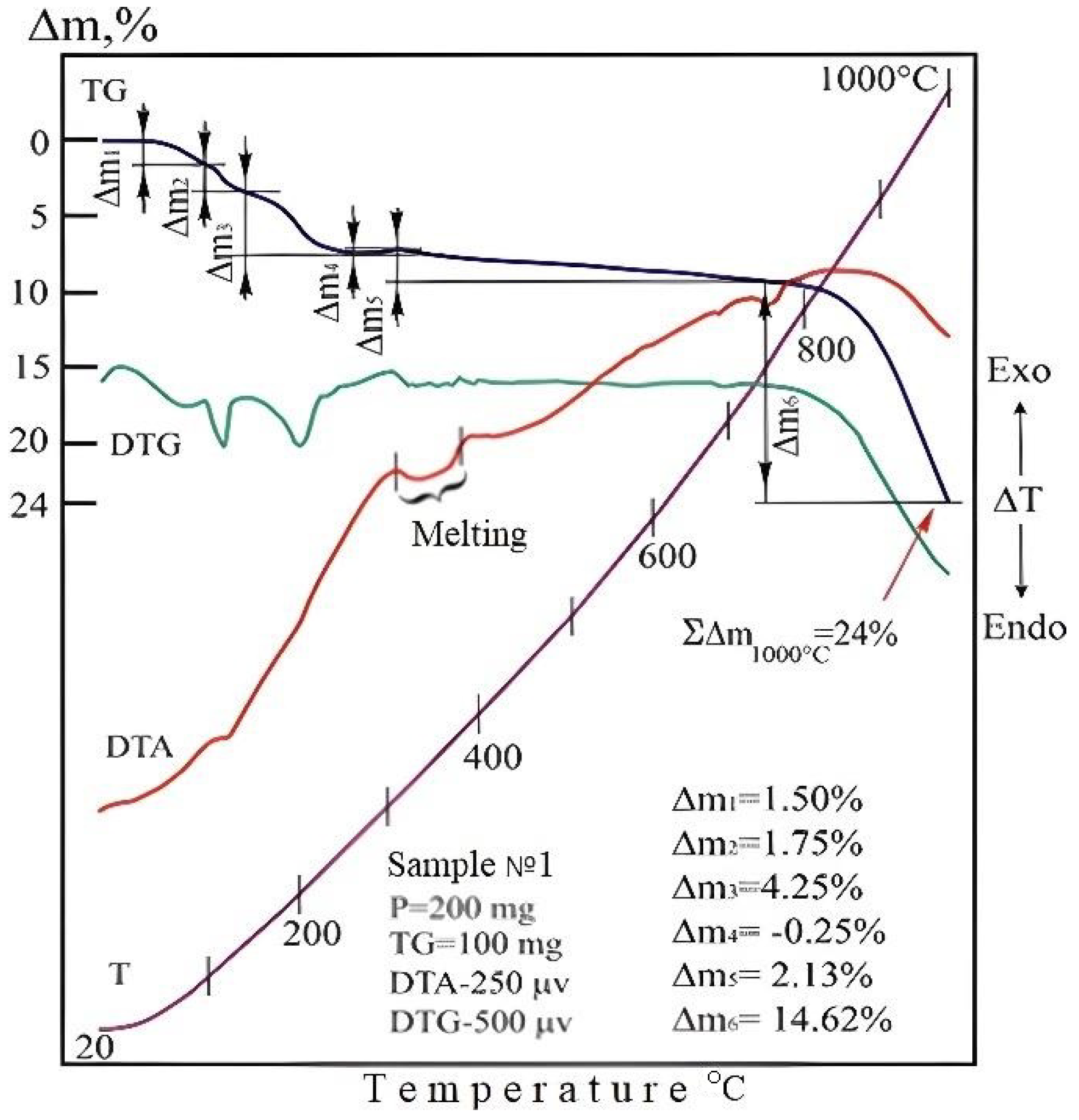
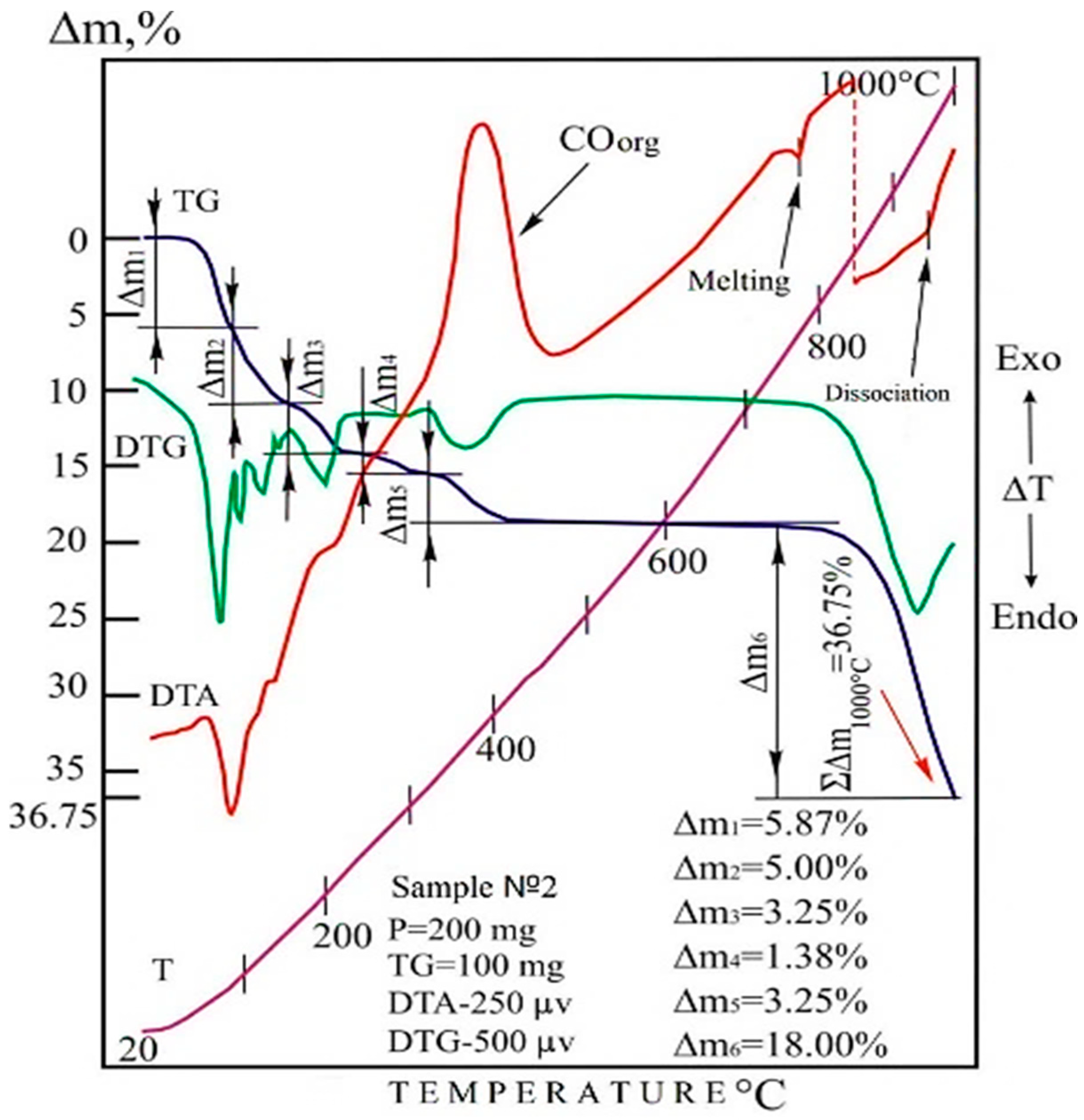

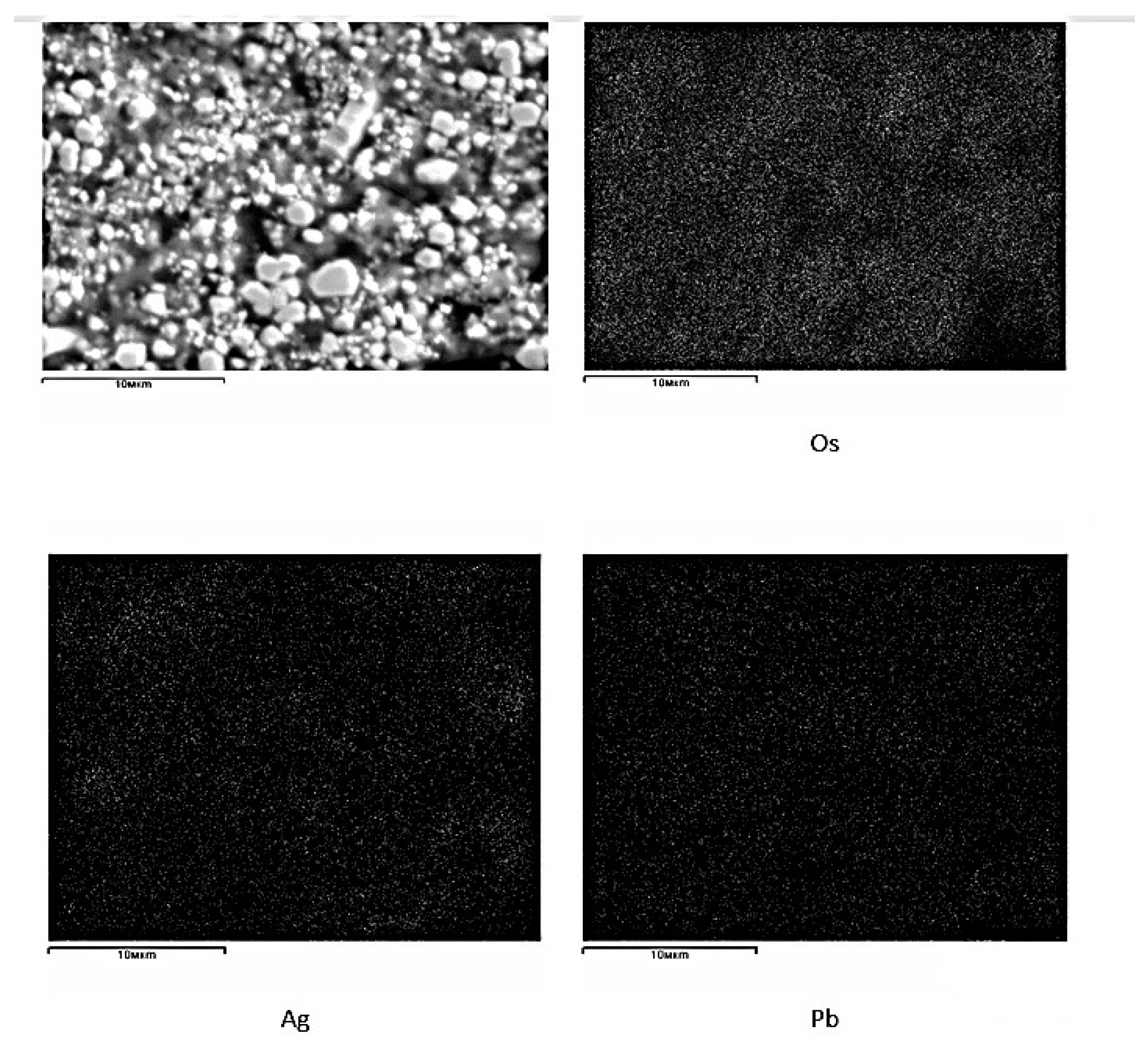
| Lead Compounds | Mass Fraction, % |
|---|---|
| Pbgeneral | 62.12–63.56 |
| Pb (PbSO4) | 53.92–61.48 |
| Pb (PbS) | 0.05–0.23 |
| Pb (PbO) | 1.51–8.80 |
| Elements | Draft Lead | Slag | Sublimates | |||
|---|---|---|---|---|---|---|
| I | II | I | II | I | II | |
| Pb | 98.5 | 95.6 | 0.05 | 1.2 | - | - |
| Cu | 0.467 | 81.7 | 0.009 | 0.66 | - | - |
| Zn | 0.085 | 22.67 | 0.026 | 4.74 | 5–6 | 72.58 |
| Na | 0.05 | 0.001 | 34.55 | 96.0 | - | - |
| Cd | 0.037 | 30.36 | 0.002 | 0.6 | 2–2.5 | 69.04 |
| As | 0.025 | 25.83 | 0.193 | 72.75 | 0.01 | 1.92 |
| Bi | 0.067 | 99.2 | 0.005 | - | - | - |
| Se | 0.1 | 35.36 | 0.03 | 5.1 | 0.1 | 63.54 |
| Hg | - | - | - | - | 20–50 | 99.4 |
| Os | 0.005 | 99.5 | <0.001 | - | - | - |
| Re | 0.0041 | 0.2 | 0.23 | 97.5 | - | - |
| Elements | Phases | |||
|---|---|---|---|---|
| 1-Phase | 2-Phase | 3-Phase | 4-Phase | |
| Na | 26.48 | 5.54 | 2.40 | 0.92 |
| S | 20.79 | 4.65 | 0.81 | - |
| O | 41.13 | 24.46 | 19.63 | 12.63 |
| K | 0.98 | 6.23 | 8.37 | - |
| Re | 3.15 | 52.52 | 62.59 | - |
| Ca | 0.37 | - | 0.10 | 0.46 |
| Pb | 3.33 | 1.99 | 1.38 | 68.90 |
| As | - | - | - | 14.24 |
| Cl | 1.74 | - | - | 2.61 |
| Zn | - | 0.77 | 1.31 | - |
| Al | 0.63 | - | - | - |
| Si | 1.02 | - | - | - |
| Possible connections | Na2SO4, NaReO4, Na5ReO6 | KReO4, Pb(ReO4)2 | KReO4, NaReO4 Pb(ReO4)2, Na5ReO6 | PbAsO4 |
| No. | Processing Method | Technological Parameters | Disadvantages of the Method | Source |
|---|---|---|---|---|
| 1 | Sludge leaching in the presence of an oxidizer. | Rhenium extraction in solution is 95–98%; osmium extraction in the gas phase is above 95%. | High consumption of expensive oxidizing agents such as hydrogen peroxide, obtaining productive rhenium solutions of complex composition containing such impurities as Pb, Cu, Zn, As, etc. | [5,10] |
| 2 | Leaching of lead compounds with concentration of rare metals in insoluble residue. | Removal of lead sulfate in solution in the form of chloride or nitrate with a concentration of osmium and rhenium in an insoluble residue. The degree of concentration of osmium and rhenium is 20–30 times. | The consumption of solutions exceeds the weight of lead sludge by 3–5 times. Significant capital expenditures are required for the disposal of the obtained solutions. | [9,12] |
| 3 | Oxidation firing. | Extraction of osmium and rhenium in the gas phase by 95–98% with subsequent concentration in subcarbon. | There is a joint transition of osmium and rhenium in the gas phase, requiring further separation. | [3,7] |
| 4 | The method proposed by the authors. | Selective separation of osmium and rhenium at the first stage of processing. Extent of osmium extraction into blister lead—99.5%; rhenium into sodium slag—97.5%. | High temperature of 1100 °C. |
| No. Samples | Plots of Lead Melt | Mass, g | Pb | Cu | Zn | Bi | Os |
|---|---|---|---|---|---|---|---|
| 1 | Upper | 124.5 | 94.2 | 1.278 | 0.196 | 0.0223 | - |
| Average | 75.5 | 96.7 | 0.421 | 0.0018 | 0.0673 | 0.002 | |
| Lower | 24.7 | 98.3 | 0.23 | 0.0008 | 0.0175 | 0.05 | |
| 2 | Upper | 126.6 | 94.3 | 1.190 | 0.1950 | 0.0221 | - |
| Average | 76.2 | 92.5 | 0.678 | 0.0009 | 0.0745 | 0.0008 | |
| Lower | 22.4 | 97.9 | 0.289 | 0.0008 | 0.0182 | 0.0590 | |
| 3 | Upper | 128.0 | 94.9 | 1.400 | 0.1870 | 0.0220 | - |
| Average | 78.11 | 97.2 | 0.028 | 0.00075 | 0.0712 | 0.0008 | |
| Lower | 19.64 | 98.5 | 0.22 | 0.0008 | 0.018 | 0.092 |
| Elements | Phases | ||||
|---|---|---|---|---|---|
| 1-Phase | 2-Phase | 3-Phase | 4-Phase | 5-Phase | |
| Pb | 51.47 | 4.24 | 41.89 | 1.04 | 30.04 |
| Os | 8.95 | 74.96 | 22.51 | 82.15 | 37.4 |
| Ag | 4.75 | 1.30 | 2.2 | 4.72 | 5.92 |
| Se | 2.32 | 1.94 | 0.71 | 3.02 | 2.94 |
| As | - | 2.96 | - | 3.11 | - |
| Fe | 0.75 | - | 0.59 | - | 1.03 |
| Cr | - | 0.49 | 0.53 | - | 0.7 |
| Ca | 0.32 | - | - | - | - |
| Cl | 2.17 | - | 0.5 | - | 1.46 |
| S | 9.32 | 1.38 | 8.24 | - | 5.38 |
| Al | - | 2.21 | - | 0.75 | 0.41 |
| O | 19.84 | 10.52 | 22.83 | 5.21 | 14.71 |
| Possible connections | PbS, PbO, Ag2O, Os | PbO, Al2O3, Os, S | PbS, PbO, Ag2O, Os | Os, PbO, Ag2O, | PbS, PbO, Ag2O, Os |
Publisher’s Note: MDPI stays neutral with regard to jurisdictional claims in published maps and institutional affiliations. |
© 2022 by the authors. Licensee MDPI, Basel, Switzerland. This article is an open access article distributed under the terms and conditions of the Creative Commons Attribution (CC BY) license (https://creativecommons.org/licenses/by/4.0/).
Share and Cite
Feruza, B.; Abdurassul, Z.; Alma, T.; Alimgazy, S.; Akmaral, S. Extraction of Rhenium and Osmium from Lead Technogenic Raw Materials of Copper Production. Materials 2022, 15, 4071. https://doi.org/10.3390/ma15124071
Feruza B, Abdurassul Z, Alma T, Alimgazy S, Akmaral S. Extraction of Rhenium and Osmium from Lead Technogenic Raw Materials of Copper Production. Materials. 2022; 15(12):4071. https://doi.org/10.3390/ma15124071
Chicago/Turabian StyleFeruza, Berdikulova, Zharmenov Abdurassul, Terlikbaeva Alma, Sydykov Alimgazy, and Serikbayeva Akmaral. 2022. "Extraction of Rhenium and Osmium from Lead Technogenic Raw Materials of Copper Production" Materials 15, no. 12: 4071. https://doi.org/10.3390/ma15124071





